Community
now browsing by category
The Delaware Tribe’s Traditional Clothing Sewing Circle

About three months ago, several members of the Delaware Tribe decided to begin meeting on a weekly basis to work on their own sewing and beading projects.
“With the pow wow coming, we thought it would be a good idea,” Delaware Councilwoman Janifer “Jan” Brown explained, referring to the Delaware Tribe’s upcoming 50th Annual Pow Wow, scheduled to take place May 23 – 25 at the Fred Fall-Leaf Memorial Campgrounds near Copan.
Chief Paula Pechonick said, “I needed time to get projects finished. Long ago my grandmother would get together with other Delaware women to sew.”
The traditional clothing sewing circle, which meets on Tuesdays 5:30 – 7:30 p.m. in the Delaware Community Center’s Forsythe Hall, is informal and social in nature.
“We wanted to have more of a sewing circle. We had projects to get done and we knew they’d be more likely to get done if we did that,” Delaware Councilwoman Jenifer Pechonick explained.
Other benefits of the gathering are encouragement and expertise offered by the more experienced participants to those just starting out.
Chief Pechonick explained the difference between appliqué and ribbon work: “[f]or ribbon work, you cut down through the layers, but appliqué you stack on top of one another.” She described a nine-layer skirt she had constructed using ribbon work to create a tulip design.
Brown pointed to Chief and said, “She’s our expert. I’ve been studying under her for 25 years.”
Anna Pechonick, age ten, said, “She made my clothes and my mom’s clothes.”
Jodi Anaya, who said she joined the class at the invitation of her Aunt Bess said: “I’m a beginner. I joined to learn more about my heritage.”
Brown said: “Your moccasin is so good. You’re gifted.”
Connie Collier agreed, admiring Jodi’s moccasin beadwork.
Collier, who also sews traditional clothing for others, was seated at the table with the others. Collier was busy making a shawl for Anna’s giveaway. Chief explained that Anna Pechonick is Head Girl Dancer at the upcoming pow wow and that it is customary for Head Girl Dancer to give gifts. The gifts will be given to the people on the pow wow committee, the staff and privately to others.
Another custom is for the Delaware to take gifts to the arena where the pow wow will take place and leave them at various spots. Sometimes, the announcer will specify that the gifts are for the elders or the women. Those within the stated category, who feel led, will go and get one of the gifts, Collier said.
“Candy will be handed out to the children also,” Collier explained.
Anaya’s Aunt, Bess Marler, said, “I’ve been doing beadwork since I was a little kid. My mom taught me when I was small. She went to Wyndotte Indian School. But I just started sewing traditional clothes three months ago. I made my moccasins and then the dress.”
Marler explained that previously she had made bracelets and necklaces by bead-weaving. Beading the moccasins she had made was similar to the bead work she had done previously. For this project the beadwork was placed on fabric and then sewn to the moccasin.
“My granddaughter Katie is usually here too. She is 16.”
Marler described the traditional clothing she had made for her: “Katie’s shawl has a hummingbird and trumpet flowers.” She explained the significance: “The trumpets are like my grandmother’s trumpet vines and Katie’s my little hummingbird.”
Regarding her attendance Anna Pechonick said, “I started this year, but I have watched my grandmother and my mom for years. My grandmother gave me a sewing machine when I was eight and I used swatches to see what kind of design I could make.”
This is not the only sewing group which meets at the Community Center, Another group, specifically for the Native American children, provides more formal instruction.
“On Thursday nights there’s a group that meets that beads and I’ve seen them make earrings. They teach them how to stomp dance too,” Anna Pechonick said.
More information about the Thursday night class, called “Lenapeowsi,” can be found on their Facebook page, Jenifer Pechonick said.
“We support the use of the Community Center,” Jenifer said. “This is a multi-generational facility with a child care center on one side and the elder nutrition program and offices on the other.”
For more information about the activities at the Delaware Community Center, visit the website at: www.delawaretribe.org or call 918-337-6590. For more about the upcoming pow wow call Lu Ann Hainline at 918-338-9907.
 Delaware Councilwoman Janifer “Jan” Brown doing moccasin beadwork at the Delaware’s traditional clothing sewing circle held on Tuesday evenings 5:30 – 7:30 at the Delaware Tribe’s Community Center in Forsythe Hall. Delaware Councilwoman Janifer “Jan” Brown doing moccasin beadwork at the Delaware’s traditional clothing sewing circle held on Tuesday evenings 5:30 – 7:30 at the Delaware Tribe’s Community Center in Forsythe Hall. |
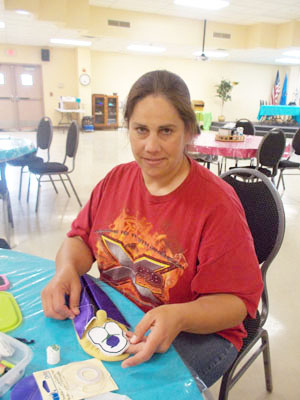 Jodi Anaya shows her moccasin with beadwork she is working on at the Delaware’s traditional clothing sewing circle. Jodi Anaya shows her moccasin with beadwork she is working on at the Delaware’s traditional clothing sewing circle. |
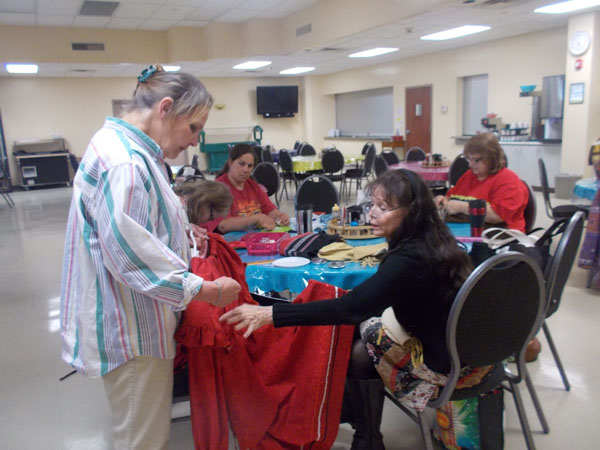 (L-R) Bess Marler shows Delaware Chief Paula Pechonick the dress she is sewing at the Delaware’s traditional clothing sewing circle. (L-R) Bess Marler shows Delaware Chief Paula Pechonick the dress she is sewing at the Delaware’s traditional clothing sewing circle. |
|
Elder’s Activities: Azaleas, Amish Food, Braum’s Ice Cream
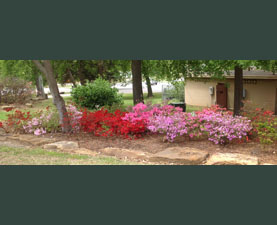
Bonnie Jo Griffith, Vice Chair, Elders Committee
Photos by Charles Randall
What a fun, fun Tuesday. The Elders Committee had a field trip on April 29. Thirteen of us ventured to Muskogee where we spent just a bit touring around Muskogee (cemeteries, castles, etc.—a bit of “killing time” activity). Then we stopped at the Amish Country Store and Restaurant and had such a good lunch. My chicken and dressing was so delicious. And, OMG the cooked carrots were to die for. Once we were full, and I mean REALLY full we loaded up in the van again. Driving through Honor Heights Park we saw some gorgeous azaleas bloomed out. Took a brief stop at their “azalea store” to look around. We then headed out of Muskogee and our driver, Charles Randall, decided to take a different route back. My thinking is that he wanted to find some bumpier roads for the comfort of us riding in the back seat of the van. Well, if that was his goal, he was SUCCESSFUL!
Had lots of laughs on the ride back. Driving back through Chouteau, Bonnie Thaxton spotted a Braum’s and we made an unplanned stop. Sundaes, ice cream cones, drinks, it was a very good thing. Once again loaded up the van and headed back, traveling through Claremore, Oologah, and Talala. Mr. Randall again was spot on about the bumpiness of the less traveled roads. Made it back to the Tribal Center about 3:45 this afternoon and the feedback from everyone who went was extremely positive. We didn’t let the really cool, overcast day stop this bunch of seniors. So much thanks to Charles and Mary Randall for organizing our event—job well done. Pat and Walt Donnell joined us with Walt riding shot gun. Mr. and Mrs. Fox and Mr. and Mrs. Fox seemed to have a good time joining in and I am not being redundant. Kay Anderson and Bonnie Thaxton provided laughs along the way. Barbara Wallace and Barbara were great back seat mates with me as we “jostled” down the road. Hope more of the seniors will join in our next adventure.
 |
 |
 |
 |
Delaware Tribal Members Get 15% Off at Monterey’s!

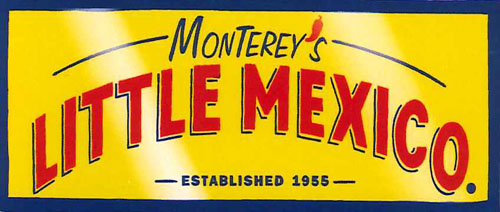
Delaware tribal members now get 15% off on meals at Monterey’s Little Mexico, 3815 SE Adams Blvd, Bartlesville.
Offer applies when you show your organization ID or member card at any Monterey’s Little Mexico. Members are also entitled to 10% off any catering order for the duration of the offer.
3815 SE Adams Blvd, Bartlesville, OK 74006
Call 918 333-5524 to Book Catering Today!
Limit 3 per table. Excludes Alcohol, 3 for $18.99 Offer, Tax, and Gratuity. Offer Expires 2/1/15.
Massage Therapy Now Available at the Delaware Tribe Wellness Center

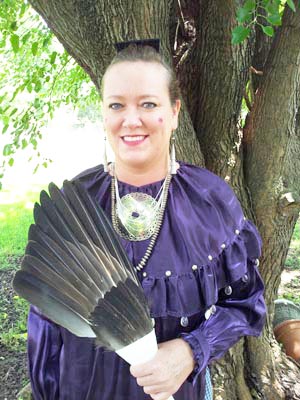 Starting in July, the Delaware Tribe Wellness Center is pleased to add a new service. Tribal member Cassandra Brown will offer massages Monday through Wednesday, 8:00 am to 8:00 pm (by appointment only). Ms. Brown has over 10 years experience as a massage technician.
Starting in July, the Delaware Tribe Wellness Center is pleased to add a new service. Tribal member Cassandra Brown will offer massages Monday through Wednesday, 8:00 am to 8:00 pm (by appointment only). Ms. Brown has over 10 years experience as a massage technician.
Rates are $45 per hour or $25 for a half-hour. To arrange an appointment, call Cassandra Brown at 918-214-7853.
The Delaware Tribe Wellness Center is open Monday through Friday from 8:00 am to 8:00 pm and Saturday 8:00 am to 1:00 pm. It is located at the Tribal Complex at 170 NE Barbara, Bartlesville, OK. (Barbara Avenue is located a block west of the Tuxedo Blvd. and Madison Ave. intersection.)
There is no fee to use the Wellness Center for Delaware and Cherokee members. Just bring your CDIB card or your tribal membership card with you. Tribal members of other tribes (with their membership card) pay just $10 per month. Anyone else can come in to get healthy for the small fee of $20 per month. Walk-in guests pay just 2 dollars a day.
For more information call 918-337-6590.
Please note that there is no medical staff on duty, so use the equipment at your own risk.
Chief Ensures Moccasin Art Continues

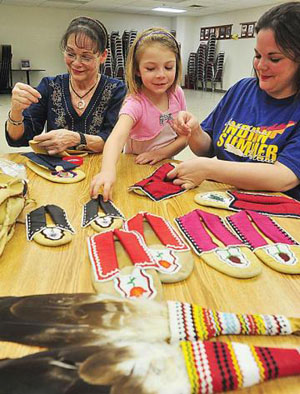 By Abigail Singrey
By Abigail Singrey
asingrey@examiner-enterprise.com
Saturday, March 26, 2011 10:07 PM CDT
The art of moccasin making has been passed down through the generations in Delaware Chief Paula Pechonick’s family, and now she sees it as her mission to make sure the tradition continues.
Pechonick’s great-great-grandmother was a moccasin-maker, and she used to travel to Pawhuska — which was an oil boom town at the time — with a load of moccasins to sell. More recently, Pechonick’s aunt — Anna Anderson Davis — passed down the art to other members of the family.
Now, Pechonick has accepted the baton from the women who went before her. Through her classes, which happen about once a year, Pechonick has saved the art of moccasin making within the Delaware tribe, Annette Ketchum said.
Tribal council member Jan Brown says Pechonick taught her in 1993, and “I just fell in love with it,” she said. She has taught her own family members now, she said, and one granddaughter embroidered a University of Oklahoma emblem on hers.
“I love it when they take it and run further than you teach them,” Brown said.
Moccasin makers “really were few and far between” before the classes, Pechonick said. “A lot of … Delaware women make their moccasins now.”
The moccasins are a key element of the traditional clothing, which for women also includes a taffeta shirt, wool skirt, tulip purse, shawl and fan.
It takes around 30 hours to make a moccasin, Pechonick said. After the buckskin is stretched and a pattern is used to cut it, then it is gathered in the toe and the tongue is stitched on. Pechonick also frequently uses elk hide rather than deer hide to make the moccasins sturdier, she said.
“The trick to making moccasins is that you sew them on both the inside and on the outside, and that makes them sturdy,” Pechonick said.
The beadwork is the most laborious part of the process, she said.
Unless she is copying a pattern from someone else, Pechonick always starts her round pattern on the toe of the moccasin with two rows of white beads and then a row of a dark contrasting color, she said.
Pechonick has come a long way in learning the craft since her first few pairs of moccasins, she said. She had looked at some moccasins at a powwow, and decided that she could make them.
When her aunt saw the final results, she decided to give Pechonick some tips on the craft.
“Aunt Anna kind of talked in parables to us, so she told me a story about moccasins without insulting my moccasins,” Pechonick said.
Now Pechonick enjoys seeing others make their own first pairs, even if the results don’t turn out quite as they had hoped.
“One gentleman came in to class and said, ‘Look, I beaded a flying squirrel,’” she said.
He had been trying to bead a turtle to symbolize his membership in the turtle clan. There are three clans in the Delawares: turkey, turtle and wolf, Pechonick said.
Beading the moccasins is a way to connect people to the Delaware culture, Pechonick said. Having a tangible object they can wear at the end of a class seems to bring satisfaction, too.
“They feel like they have accomplished something, also,” Pechonick said.
Note: This article originally appeared in the Bartlesville Examiner-Enterprise on March 26, 2011. Used by permission; copypright Bartlesville Examiner-Enterprise, all rights reserved.
Traditions Carried On: Delaware Woman Passes on Art of Beadwork

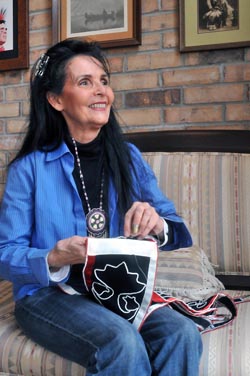 By Abigail Singrey
By Abigail Singrey
Staff Reporter
Monday, January 24, 2011
Annette Ketchum began learning bead work out of necessity. Her husband, former Delaware chief Dee Ketchum and their children needed dance sticks and beaded handles for their eagle feather fans to take to a powwow.
She soon discovered she had a real love of beadwork.
"It was therapeutic," Ketchum said.
Her grandmother began teaching her when she was young, but it was not until later that she began to seriously study how to do it.
The Delaware Powwow was founded in 1964 and became an annual event in Copan. Ketchum decided her family needed clothing to wear.
The Ketchums were living in Lawrence, Kan., in the early 1970s. Her daughters were playing in a field and found a dead bird, which they brought home. Ketchum decided to use it to make dance fans. They discarded it all but the long wing feathers — which provided enough to make two fans.
The two girls — who were around 7 and 8 years old — helped Ketchum bead the fans, and they took them to the powwow that summer.
When the elders of the tribe saw the fans, they were shocked. Ketchum had accidentally used an owl, which was an omen of death to the Delaware.
"We didn’t know the bird was an owl," Ketchum said.
She credits this incident as being a turning point. They put the dance sticks away until they could find the proper feathers, and Ketchum began to learn more about how to make the traditional clothing.
Today Ketchum has made two bandoliers, which cross over the shoulders like a sash. She also sews the traditional clothing for her family, as well as beaded dance sticks, otter hats, tulip purses and more.
"Anyone can do it if they have the patience," Ketchum said. "Everybody has (some artistic ability), because everyone has their own idea of what looks good."
She uses traditional Delaware patterns that she modifies to fit the space she has. Ketchum starts by putting the design on the bandolier, and then she fills in the background with beads. Every so often, she will put in a larger bead or a darker bead to draw the eye and make the beadwork more interesting, she said.
Her favorite part is choosing colors that will go together, she said.
The Delawares use mostly primary colors, she said, and she tries to work the Delaware colors — red, black and white — into each piece she does. She refuses to use pastels.
"You (don’t) get the feeling of a sunset in the southwest when you look at my work," Ketchum said.
Ketchum has been working to pass on the skills she learned first from her grandmother to the younger members of the tribe. She began teaching her grandchildren to string beads when they were four, she said, and by the time they were six, they were using a needle.
She has held classes to teach the peyote stitch, or gourd stitch, which can be used for flatwork such as the bandoliers.
She hopes to complete her third bandolier soon, so she can pass them on to her three grandsons someday. Meanwhile, the need for new clothes for the powwow will keep her busy sewing and repairing, she said.
Note: This article originally appeared in the Bartlesville Examiner-Enterprise on January 24, 2011. Used by permission; copypright Bartlesville Examiner-Enterprise, all rights reserved.
 D5 Creation
D5 Creation